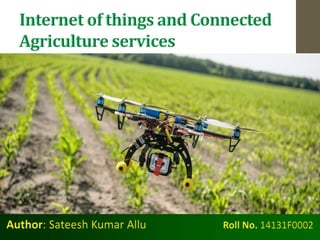
Internet of Things And Agriculture Services
- 1. Author: Sateesh Kumar Allu Roll No. 14131F0002
- 2. Agenda • What is Agriculture and Farming • Connected world and agriculture • 21st century global challenges in - food production • Agriculture Market in India • Connected solution overview • Solution architecture • Implementation challenges
- 3. Great hardware and information companies with technology and operations that could really help growers. But surprisingly none of them actually worked together.
- 4. And when these systems don’t work together, no one benefits. Not the hardware companies, not the growers, and not the people that try to help growers get the most out of their crops
- 5. The Global Food and Agriculture System The 21st Century Challenges: • Feed a growing, more prosperous world – and hopefully better than we have in the past • Increase food output 50% by 2025 • More than double by 2050 • Contribute to national energy security in many countries • Preserve/enhance the environment • Maintain the rural cultural heritage With these constraints: • While using the same or fewer resources • And, do this against t he backdrop of global climate change!
- 6. Global population growth 0 1 2 3 4 5 6 7 8 9 10 1950 1955 1960 1965 1970 1975 1980 1985 1990 1995 2000 2005 2025 FC 2050 FC Source: United Nations, 2006 Billions 8.0 9.2 Source: International Monetary Fund (IMF), World Economic Report, Apr. 2008
- 7. Indian agriculture Industry India is known as the ‘Land of Agriculture’ which has many traditions and even a large variety of cultures. Approximately 70% of the Indian population are connected with agriculture and its related activities. India ranks first in the production of sugarcane and second in the production of rice in the world. Apart from these, many other cereals, tea, coffee etc. add to the agricultural output from India. Spices are also well known worldwide from the incredible India.
- 8. Modern Indian Agriculture Modern India implements new techniques in agriculture to increase the quantity and quality of the yield. Many agricultural products are exported on large basis worldwide which add to the economy of India. New modern farm machinery and financial schemes are provided by the government to encourage agriculture in the rural areas of the nation.
- 9. The environmental challenge • Protect the natural resource base • Prevent degradation of the land • Improve air quality • Develop more efficient water use, improve quality • Improve wildlife habitat • Avoid biodiversity loss • Cultural protection aspect (viewscapes, farm structure, practices) • Post-Industrial Challenge: increase productivity - reduce intrusion
- 10. Growingresourceconstraints 0.0 0.1 0.2 0.3 0.4 0.5 0.6 0.7 0.8 0.9 B razil R ussia India C hina Indonesia U SA M exico South A frica Zim babw e HectareofArableLand Arable Land (ha) per person Most populous countries have least room to expand Produce more with less… Land | Water | Labor
- 11. Growing resource constraints • Farm demographics (aging) and migration to cities importantly influence agricultural labor availability • High-tech machines, complex production processes and strict production regulations require skilled labor • Tighter restraint on immigration encourages mechanization, innovation – affects capital requirements 21stCenturyBeefClub Source: UN-Water and FAO Produce more with less… Land | Water | Labor
- 13. 13 STRENGTHS • Rich Bio-diversity • Arable land • Climate • Strong and well dispersed research and extension system OPPORTUNITIES • Bridgeable yield crops • Exports • Agro-based Industry • Improve productivity by cross market collaboration WEAKNESS • Fragmentation of land • Low Technology Inputs • Unsustainable Water Management • Poor Infrastructure • No central market • Water scarcity THREATS • Unsustainable Resource Use • Unsustainable Regional Development Agricultural market in India
- 15. Enabling factors • Agricultural schools • Agricultural research organizations • NGO’s • Private research organizations • Government body dealing with agricultural research and development • Weather forecasting labs • Soil testing labs • Food quality labs Enabling factors: • Irrigation system • Automations system • Fertilizers spraying • Farm Tilting • Crop planting • Harvesting • Weather forecasting • Crop protection Enabling factors: • Access to financial services • Pre-production planning • Financial planning • Factors of safety • Environmental considerations • Scope of using technology Enabling factors • Buyers of good • Retail market e.g. BigBazar • Fertilizers dealers • Local buyers • Inter and intrastate buyers of good • Factories demanding good nearby e.g. sugarcane, cotton, soyabeen Farmer Connected Agriculture Agricultural value chain
- 18. Proposed solution Overview: Push info to farmer than pull by farmer. Connect farmer to complete agricultural supply chain. Provide farmer latest technology and expert advice. Provide technology end to end implementation support. Standardized programs for major crops e.g. sugarcane program Advanced connected pay per use services. Monitoring to make decisions. Build and provide custom solutions to farmer. In house implementation of connected technology in other services products . E.g purchase device and create custom protocols for standard services.)
- 19. Functional architecture Control Center Knowledge center advanced Data Processing Help center Farm land/Local system Onboard Control and data collection e.g. Connected tractors 1 2 ERP system 8 7 4 3 5 6 Implementati on in charge
- 21. e.g. Wireless irrigation system fig.Proposed system architecture
- 22. e.g. Solar powered wireless irrigation Solar powered
- 23. e.g. Retail services Customer support Farmer calls toll-free
- 25. Conclusion • Better decision making system for farmer • Better production planning • Increased productivity • Increased profits • Increased food production • Water conservation • Data collection can be used by government policy makers
